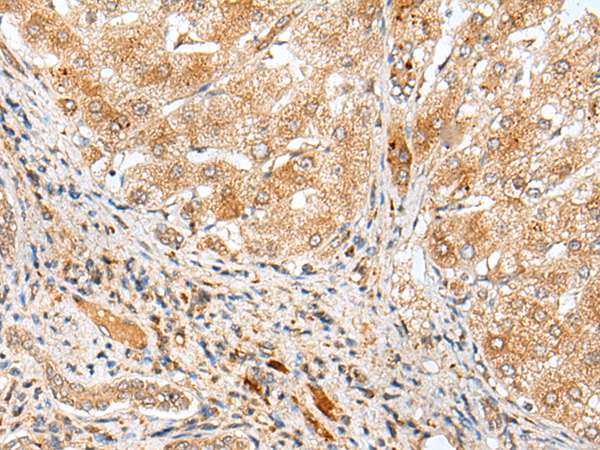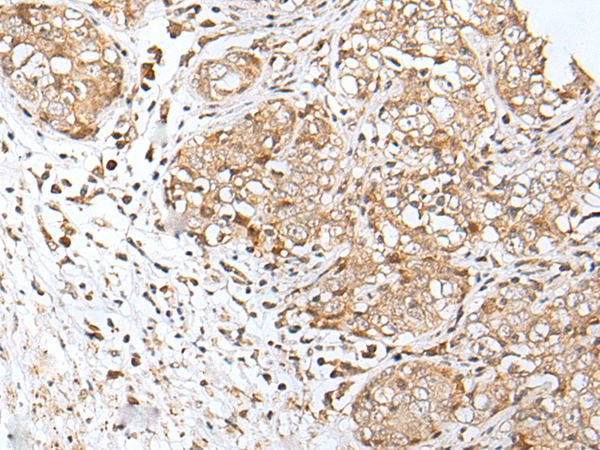

| WB | 咨询技术 | Human,Mouse,Rat |
| IF | 咨询技术 | Human,Mouse,Rat |
| IHC | 1/25-1/100 | Human,Mouse,Rat |
| ICC | 技术咨询 | Human,Mouse,Rat |
| FCM | 咨询技术 | Human,Mouse,Rat |
| Elisa | 1/5000-1/10000 | Human,Mouse,Rat |
| Aliases | ADAMTS-4 |
| Host/Isotype | Rabbit IgG |
| Antibody Type | Primary antibody |
| Storage | Store at 4°C short term. Aliquot and store at -20°C long term. Avoid freeze/thaw cycles. |
| Species Reactivity | Human |
| Immunogen | Synthetic peptide of human ADAMTS3 |
| Formulation | Purified antibody in PBS with 0.05% sodium azide and 50% glycerol. |
+ +
以下是关于ADAMTS3抗体的3-4篇参考文献的简要总结(文献信息为示例性概括,具体内容请以实际文献为准):
---
1. **文献名称**: *ADAMTS3 is required for lymphangiogenesis and lymphatic vessel function*
**作者**: Souma T, et al.
**摘要**: 研究揭示了ADAMTS3通过激活VEGF-C蛋白在胚胎发育和淋巴管生成中的关键作用,并利用特异性抗体证明其缺失导致遗传性淋巴水肿。
2. **文献名称**: *ADAMTS3-mediated proteolytic processing of fibrillin-2 regulates extracellular matrix remodeling*
**作者**: Dubail J, et al.
**摘要**: 本文利用ADAMTS3抗体验证了其对细胞外基质成分(如原纤维蛋白-2)的酶切活性,提示其在组织发育和疾病中的潜在调控机制。
3. **文献名称**: *ADAMTS3 as a novel regulator of TGF-β signaling in fibrosis*
**作者**: Nandadasa S, et al.
**摘要**: 通过ADAMTS3抗体阻断实验,研究发现ADAMTS3通过调节TGF-β通路参与纤维化疾病进程,可能成为治疗靶点。
4. **文献名称**: *Therapeutic targeting of ADAMTS3 in hereditary lymphedema*
**作者**: Apte SS, et al.
**摘要**: 研究开发了人源化ADAMTS3中和抗体,并在动物模型中验证其通过增强VEGF-C信号改善淋巴管功能障碍的效果。
---
**注意**:以上文献信息为基于领域知识的示例性概括,实际引用时请通过PubMed、Google Scholar等平台核对具体文献细节及最新进展。
The ADAMTS3 (A Disintegrin and Metalloproteinase with Thrombospondin Motifs 3) antibody is a research tool targeting the ADAMTS3 protease, a member of the ADAMTS family involved in extracellular matrix (ECM) remodeling and proteolytic processing of bioactive molecules. ADAMTS3 is best known for its role in activating procollagen I and II through cleavage of their N-propeptides, a critical step in collagen fibril assembly. It also processes other ECM components, such as versican, and participates in lymphatic vessel development by cleaving VEGF-C, a key regulator of lymphangiogenesis. Mutations in ADAMTS3 are linked to human disorders like Hennekam syndrome, a rare autosomal recessive condition characterized by lymphedema and developmental abnormalities.
The ADAMTS3 antibody is primarily used in biomedical research to study the enzyme's expression, localization, and function in tissues, particularly in connective tissues, skin, and lymphatic systems. It aids in investigating ADAMTS3's involvement in pathological conditions, including fibrosis, osteoarthritis, and lymphatic dysplasia. Commercial ADAMTS3 antibodies are typically developed in rabbit or mouse hosts, targeting specific epitopes within its catalytic domain, disintegrin-like region, or thrombospondin motifs. Validation often includes Western blotting, immunohistochemistry, and knockout controls. Challenges in antibody development stem from structural complexity, including multiple domains and post-translational modifications. Reliable ADAMTS3 antibodies are crucial for elucidating its biological roles and exploring therapeutic strategies for related diseases.
×